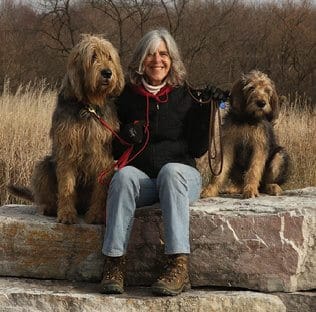Purebred Otterhounds – The Undoodles
By Eibhlin Glennon
“Is that a labradoodle?”
“No, it’s an Otterhound.”
“A what? I never heard of them. What were they bred to do?”
“Hunt river otters.”
“Oh. My friend has a labradoodle.”
Probably every purebred Otterhound owner has been part of a conversation like this. Doodles, labras or goldens, are soaring in popularity as are a number of cross-breeds, frequently called “designer breeds.” At the same time, some of our oldest breeds, like purebred Otterhounds, are fighting for survival. All dog breeds were “designed” by humans through selective breeding, usually to perform certain functions like hunting, herding or guarding. Their distinctive appearances resulted from the traits needed to perform their jobs.
Today’s designer dogs are often bred solely for looks. Take the Labradoodles and Goldendoodles who, like Otterhounds, are large, shaggy dogs with doofus expressions that attract owners and passersby. Unlike Doodles, purebred Otterhounds have predictable looks and behaviors, dominated by their sense of smell. In contrast, despite claims that Doodles do not shed, they wear a variety of coats from slightly wiry to curly to soft and fluffy. Most shed and mat, thanks to one parent, and need to be clipped, thanks to the other. The combination of the Poodle hair that keeps growing and the Lab and/or Golden fur that sheds profusely creates a dog who needs a vacuum and a groomer. They tend to be more substantial than Poodles, with many of their features. Curiously, many of them are larger than either of the breeds behind them and few of them hunt, unlike the Goldens, Labs, and Poodles in their ancestry.
Purebred Otterhounds are an old breed of Scenthounds with wiry outer coats that are waterproof, and softer undercoats to keep them warm as they patrol land and water to keep river otters from decimating the fish populations in the British Isles. A good coat repels water and dries quickly. Everything about this scenthound, from its size to its coat to its large feet with webbing to its sickle tail waving in the tall brush, is designed to make it efficient at scenting and pursuing its prey on land and water. Persistent and independent, Otterhounds are pack hounds and love fellow dogs, cats, and of course, people. But more than anything, they have those noses inherited from their Bloodhound and Welsh Foxhound ancestors that can scent on land and water. All those cute features have a purpose. While otters are endangered, the hounds still pursue careers in tracking, trailing. And while they shed, they shed less than most dogs and their hair never needs to be clipped. Otterhounds do not need groomers—just a comb and brush applied once a week.
Purebred Otterhounds are an old breed of Scenthounds with wiry outer coats that are waterproof, and softer undercoats to keep them warm as they patrol land and water to keep river otters from decimating the fish populations in the British Isles.
The Doodle population is on the rise, despite the often-high purchase price and upkeep costs, while the purebred Otterhound is nearly as endangered as the otters they pursued. With fewer than 1,000 remaining in the world, these clowns with the keen noses and sociable nature may soon go the way of the Passenger Pigeon. And that would be a loss. They possess most of the traits and looks of the Doodle, and more—and they breed true. They can hunt, track, and visit folks in nursing homes and hospitals, and kids in schools. They make great bed warmers on winter nights and they can find your keys and gloves for you. And they need us fanciers to insure that they are not casualties of our newer designer breeds. Looks aren’t everything.
Purebred Otterhounds – The Undoodles
By Eibhlin Glennon
This article first appeared as the February 2022 Otterhound Breed Column in the AKC Gazette (https://www.akc.org/products-services/magazines/akc-gazette/) and is reproduced here with permission.








